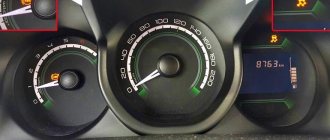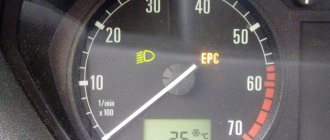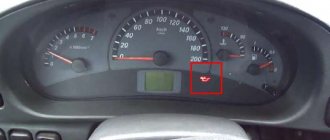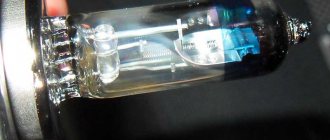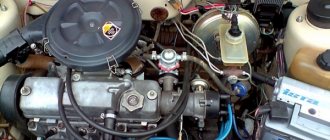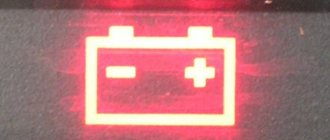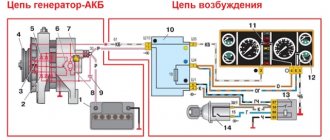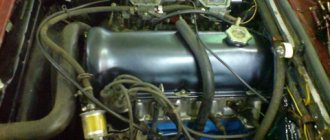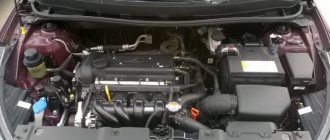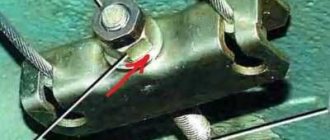Don't panic
This is a signal to the driver that a breakdown has occurred in the anti-lock braking system. Many people panic and are afraid to travel. Sometimes the car is dragged on a tow truck or on a cable, and the reason is that the ABS light is on.
No need to worry, because the brakes on the car work. Check to see if the brake fluid has leaked, try pressing the brake pedal. The car is slowing down, only the ABS system has failed. This means that on the way to the repair site you should not brake sharply so that the wheels do not skid.
Advantages and disadvantages of the system
Let's look at the main advantages of the ABS system:
- maintains vehicle controllability and stability during emergency braking, bad weather, etc.;
- in most cases it reduces the braking distance;
- increases the efficiency of the braking process;
- provides better vehicle maneuverability on slippery road surfaces.
The anti-lock braking system also has disadvantages: its use increases the braking distance on soft soils (sand). On such surfaces, the wheels, on the contrary, must be blocked. In the latest generations of ABS, this defect has been practically eliminated: the system has “learned” to determine the type of surface, and then implement a separate algorithm for a specific coating.
How does ABS work?
The electronics regulate the brake force on all wheels, preventing them from locking when braking, but allowing the car to stop quickly. By braking sharply, the car will not lose stability.
If the system is out of order, or it is not installed on the car at all, then the wheels will lock during sudden braking. A strong skid may occur, especially in winter, or when turning. If the ABS is working properly, this will not happen. Even when turning, you can press the brake pedal sharply - there will be no skidding.
If the ABS light is on, the reason is a system malfunction. This is easy to check - accelerate to a speed of 40 km per hour and sharply press the brake pedal to the floor. If there is no pedal vibration and the wheels are skidding, then the ABS is not working.
If the system is working properly, you can sharply press the brakes and try to go around the obstacle. In this case, no skidding will occur. If the anti-lock braking system fails, the car will skid and hit this obstacle.
Purpose of ABS
The anti-lock braking system, based on its operating principle, imitates the actions of an experienced motorist who uses intermittent braking on a slippery road to prevent the car from skidding. And here the question arises: why do we need an electronic system when the driver himself can perform these actions? Cars that do not have ABS installed are quite difficult to control during heavy braking, and in many situations it is simply impossible to manage without it.
Note! The anti-lock braking system is automatically activated 15-20 times per second, resulting in minimal braking distance in the event of emergency braking. A person is physically unable to work at such a speed.
Perhaps the main advantage of ABS is that the driver, even under heavy braking, can make the car obey the steering wheel. When this device is absent, during the braking process the car will slide uncontrollably along a straight path, despite all the efforts of the driver to level the movement of the personal vehicle by turning the steering wheel.
When ABS , you can hear a soft cracking sound in the cabin, indicating the functioning of the executive unit, and feel gentle and frequent pushes on the brake pedal. Those motorists who have not previously dealt with such a system will need some time to get used to this innovation.
The car's anti-lock braking system has proven itself to be excellent, but, nevertheless, there were a number of dissatisfied motorists who claim that no electronics can replace an experienced driver, because he is much better able to navigate a difficult situation on the road and take the right actions.
Note! ABS does not interfere with the braking process at all, but serves as an indispensable assistant in preventing an irreparable traffic situation. Thanks to the anti-lock braking system, the uncontrollable mountain of iron into which the car turns during heavy braking begins to obey the steering wheel and is capable of performing at least some maneuvers.
Causes and their elimination
- Check the electronic unit first. It is located under the hood in the same housing with the hydraulic accumulator.
You can recognize it by the large number of brake pipes. It contains the electronics and connector. Disconnect it by first turning off the ground, or removing the negative cable from the battery. Inspect the connector to see if water has entered it or if the contacts are damaged. It happens that the contacts oxidize, despite the protection, water or dirt gets in. If moisture is detected, blow, dry, clean. - Check the fuses that supply power to the ABS unit. There may be several of them, replace the faulty ones.
- Next you will need a car lift or pit. Inspect the wires that go to the wheel sensors to see if they are damaged. The sensors are screwed into the hub, and the wires are dangerously close to moving parts.
It often happens that they fly off the mounts or get rubbed by the wheel or turning elements. Check the wires and connectors - everything should be in good condition. ABS wheel sensors are made with a wire and a connector at the end. Make sure there is no moisture, dirt or rotted oxidized wires. - If everything is in order, but the ABS light is still on, you will have to contact a car service. An error in the anti-lock braking system cannot always be resolved by simply removing the battery terminal. Usually the light comes back on if the problem is not resolved.
If you have repaired the ABS problem yourself, in most cases the light will go out after a few trips with the brake pressed. If everything is in order, the system will see this and turn off the lamp.
This is all the information related to self-diagnosis. It’s unlikely that you’ll be able to find anything else on your own. A good car service center will connect a scanner to your Lada Granta, which will be able to read the system and identify the cause. Most often the sensors or control unit are to blame. Subscribe, good luck to everyone on the roads, look forward to many more interesting things!
Source
Checking the quality of work performed
After replacing the sensor, its functionality is checked. To do this, it is enough to accelerate to a speed of 40 km/h on a flat, safe section of the road and perform sharp braking. If the car stops without pulling to the side, vibration is transmitted to the pedal and a specific sound of brake pads being activated is heard - the ABS system is operating normally.
Today you can easily find and buy any ABS sensors - from expensive original devices to analog parts at an affordable price. Remember that proper selection of system elements plays an important role in its uninterrupted operation. When choosing a sensor, study the manufacturer's instructions and make sure that it fits the car, and this review will help you replace the device yourself.
I purchased a controller for DRLs with the ability to control it from a speed sensor. The manufacturer has a description of the installation with a pulse sensor from the box. Only cars with ABS.
What can you come up with to remove the signal from the wheel sensor?
Please explain how this ABS sensor works? Is it possible to test the health of the sensor with an LED?
- Incorrect speedometer readings on VAZ Largus - 3 answers
- Where is the speed sensor located and how to change it, Lada Largus? – 1 answer
- Is it possible to disconnect the speed sensor in Lada Largus? – 0 replies
If you are interested in the operation of the sensor itself, then briefly it looks like this.
The sensor is an inductive sensor that contains a generator - it refers to three wire sensors (inductive and Hall sensors, that is, active). When the sensor is located near a gear wheel, at the moment when a tooth appears next to the coil, the generation is disrupted. This disruption is converted by the electronic circuit into a rectangular pulse at the output.
If we consider the work further, the ABS system converts these impulses into wheel rotation speed, compares the rotation speeds and adjusts the braking forces without allowing the wheels to lock. Naturally, the algorithm of the system’s operation is much more complicated, but for a general understanding of the work, it makes no sense to delve into these jungles.
Front wheel speed sensor
This is what the sensor looks like in the hub assembly (steering knuckle): 1 – speed sensor mounting ring; 2 – inner ring of the front hub bearing; 3 – front wheel speed sensor; 4 – wheel hub; 5 – steering knuckle
Wheel bearing with sensor: 1 – magnetic bearing washer; 2 – speed sensor; 3 – hub bearing; 4 – speed sensor mounting ring
Jack up the car and place it on reliable stands, or place it on a two-post lift, apply the parking brake and turn off the ignition.
Remove the front wheel.
(Raise the car to a height convenient for performing work).
1 — bracket for fastening the speed sensor wiring harness; 2 — fender liner clamp; 3 — front wheel arch liner; 4 — front wheel speed sensor; 5 — bracket for fastening the speed sensor wiring harness on the front suspension strut; 6 - steering knuckle
Remove fastener 2, Figure 21-2, front wheel arch liner in the area where the speed sensor wiring harness is located (flat-head screwdriver).
Note: For ease of operation, you can remove the front fender liner (see here)
Remove the speed sensor wiring harness from the grooves in bracket 5 of the front suspension strut and from holder 1 on the mudguard of the engine compartment.
Remove insulating foam 1, Figure 21-3, from the knuckle speed sensor mounting socket (optional).
Figure 21-3 — Removing the front wheel speed sensor:
1 - insulating foam; 2 — front wheel speed sensor; 3 - latch
Remove speed sensor 2 from the mounting hole on the steering knuckle by using a screwdriver to press out the locking tab of sensor 3 (flat screwdriver).
Disconnect the speed sensor wiring harness connector from the front wiring harness and remove the sensor.
Attention. The wheel speed sensor insulating foam must be replaced.
Install insulating foam into the speed sensor mounting slot on the steering knuckle.
Connect the speed sensor wiring harness connector to the wiring harness
Install the speed sensor into the mounting hole on the steering knuckle until the latch engages.
Install the speed sensor wiring harness into the grooves of the front suspension strut bracket and into the holder on the mudguard of the engine compartment.
Secure the front wheel arch liner with the clamp.
The abs light came on in the car
1200 rub. for the photo report
We pay for photo reports on car repairs. Earnings from 10,000 rubles/month.
Write:
Some car enthusiasts are afraid that when the ABS light is on, it somehow affects the operation of the braking system as a whole. They urgently begin to scour the entire Internet in search of an answer to why the ABS light is on and what to do. But don’t panic so much, the brakes on your car should be in perfect order, only the anti-lock system will not work , which, in principle, is not critical, although in some emergency situations it helps a lot. To understand the system, I recommend reading about ABS.
Principle of operation
It works as follows: in the gearbox there is a special mark on the gear wheel, which, when this wheel rotates, generates an impulse using a speed sensor. It is by the frequency of these pulses that the speed of the Lada Granta is determined.
The DS on the Grant, like on many cars, is located quite low, so it is exposed to water and dirt. If we remember that the speed sensors themselves on domestic cars are not highly reliable, then it becomes clear why they fail so often.
Signs of a malfunctioning speed sensor:
- The speedometer needle does not react to speed in any way (it lies at zero);
- Electric power steering does not work;
- The speedometer readings change, but do not correspond to reality.
What to do if the ABS light is on?
It is worth noting that the system works normally if the ABS icon lights up when the ignition is turned on and goes out after a couple of seconds. The first thing to do if the ABS light is constantly on is to check the fuse for this system, and also inspect the wheel sensors.
Quite often, the sensor connector on the hub either oxidizes or the wires fray. And if the ABS icon is on after replacing the pads or hub, then the first logical thought is that you forgot to connect the sensor connector . The presence of dirt on the sensor also causes the indicator to light up.
Quite often, car owners may be frightened by the appearance of an orange ABS icon after a good slip. In this case, you shouldn’t bother at all: brake sharply a couple of times and everything will go away on its own - the control unit’s normal reaction to such a situation. When the ABS light does not light up constantly , but periodically, then you need to inspect all the contacts, and most likely, the cause of the warning light can be quickly found and eliminated.
Features of breakdowns
Also, the reason why the ABS light is on may lie in severe contamination of the working surface of the sensor, which is located on the wheel. In this situation, it is enough to wash the car so that the ABS indicator goes out.
It is worth remembering how long ago the “iron horse” underwent a technical inspection at a service station and how exactly the check was done, because many inexperienced technicians perform wheel diagnostics by removing the wires from the sensors. After this, would-be specialists forget to connect the previously removed wires, so the ABS indicator on the panel continues to light.
If there are problems with the control unit, it will be difficult to fix them. You can detect it using the on-board computer, which will show the system error code. Based on the information received, a problem with anti-locking is calculated. It will not be possible to replace the ABS sensor on your own, so it is important to contact a specialist car service.
Causes of ABS error
The main possible reasons for a constantly burning ABS light on the dashboard:
- the contact in the connection connector has disappeared;
- loss of communication with one of the sensors (possibly a wire break);
- The ABS sensor has failed (the sensor needs to be checked and then replaced);
- the crown on the hub is damaged;
- The ABS control units have failed.
After inspection and, it would seem, elimination of the cause, it is very easy to check the operation of the ABS; you just need to accelerate to 40 km and brake sharply - the vibration of the pedal will make itself felt and the icon will go out.
If a simple inspection for damage in the sensor circuit to the unit does not reveal anything, then diagnostics will be needed to determine the specific error code for the anti-lock brake system. On cars where an on-board computer is installed, this task is simplified; you just need to clearly understand the decoding of the code and where the problem could arise.
Currently, all LADA models (Lada XRAY, Vesta, Largus, Granta, Kalina, Priora, Niva 4×4) without exception are equipped with ABS (anti-lock braking system). During the operation of the car, many owners notice that the ABS and ESC lamps (if this system is available) light up on the instrument panel. Let's figure out how to solve this problem and improve the design.
Generations of anti-lock braking system
It took 14 years of effort from a huge number of engineers to create the ABS system. ABS has been produced since 1978, its creator is Bosch.
The first generation of the system (1970) was called ABS-1. This electromechanical product was not reliable and durable due to the thousands of analog components that were used in the ECU. Although the main function of ABS was fulfilled, the product was not suitable for mass production.
Second generation (1978). ABS-2 from Bosch first began to be installed as an option in Mercedes-Benz S-Class cars, and after some time in BMW 7 Series limousines. The number of components was reduced to 140, and the weight of the hydraulic unit was 6.3 kg.
In subsequent generations of ABS, Bosch engineers relied on improving the system and reducing its size. So, in 1980, ABS-2E was released, in which the mass of the hydraulic unit was already 4.9 kg, and the number of components was reduced to 40. In 1995, ABS 5.3 appeared with a mass of the hydraulic unit of 2.6 kg and 25 components. In 2003, ABS 8 was released, in which there were 16 components, and the weight of the hydraulic unit was reduced to 1.6 kg. Since 2010, Bosch has been releasing the 9th generation of the ABS system, which is distinguished by its compact dimensions and hydraulic unit weighing only 1.1 kg.
Why does the ABS and ESC light come on?
ABS malfunction may be caused by:
- failure of wheel rotation sensors;
- malfunction of the hydraulic valve block;
- damage to the wiring.
If the ABS malfunction indicator light comes on, you must contact a service station as soon as possible for diagnostics (read error codes) and repairs.
The most common cause of ABS failure is damage to the wiring near the ABS sensor connector. It is located under the fender liner, but is still not well protected from moisture and dirt.
As a result, the wires oxidize and break, and the ABS lamp lights up.
Some nuances
Replacing sensors that are installed on the steering knuckles of the front wheels is much faster, since access to these parts is more convenient:
- The car is jacked up and the required wheel is removed.
- The bolts that secure the sensor are unscrewed, and the device is removed from the seat.
- The wiring fastening is released and the connector plug is disconnected.
- Installation of a new sensor is carried out in the reverse order.
Attention! When installing a new sensor, you must ensure that no dirt gets into the place where it fits.
Before replacing the sensor, reasons that could cause it to malfunction should be eliminated. Particular attention should be paid to specific problem areas found in each car model. For example, all FORD cars manufactured before 2005 suffer from interruptions in the operation of electrical equipment that occur as a result of frequent short circuits, and the pain point of the ABS system of these cars is the quality of wiring insulation. In this case, it will be possible to repair the sensor instead of completely replacing it.
How to repair wiring
We remove the wheel, and then the locker (for the front wheel, turning out the fastening screws) or the protective shield (for the rear wheel, turning out the two fastening nuts “10”). Press the latch and disconnect the block with wires from the ABS sensor. We inspect the connector and make sure there is no corrosion or damage. In case of damage, we restore the integrity of the wires:
We treat it with a special means for cleaning electrical contacts (for example, graphite grease) and clean the contacts from oxides. We clean the wheel speed sensor and the surface around the sensor from dirt.
Attention! Keep ABS sensors away from magnets as this may cause damage.
Front Wheel Speed Sensor Installation Procedure
- Install the wheel speed sensor to the steering knuckle. Secure the sensor with a bolt.
- Insert the sensor harness into the hole in the wheel arch, insert it into the rubber bushing and secure the bushing in the hole.
- Secure the harness using the bushing fasteners and clamps to the wheel arch.
- Install the wheel.
- Lower the car.
- Connect the front wheel speed sensor connector.
- Connect the negative battery cable.
Replacing ABS sensors
If the cause of the malfunction is not in the wiring, but in the ABS sensor itself, we replace it. To do this, first unscrew the fastening screw with a Torx T30 key, and then remove the sensor wiring harness from the bracket. The photo shows a Lada Vesta car; on other Lada models the work is performed in a similar way.
Instructions for replacing the front wheel ABS sensor:
Instructions for replacing the rear wheel ABS sensor:
How to modify the design
To protect the wiring harness from the environment, you can use a D-shaped seal. We lay the wires in it and wrap it with electrical tape. We put everything in the corrugation. We glue the cover covering the ABS sensor connector around the perimeter with the same sealant. This will prevent moisture and dirt from entering the area where the sensor and connector are located.
Attention! If the ABS fails, the brakes remain operational, but the braking efficiency is reduced, which is especially dangerous on some surfaces. See why.
An anti-lock braking system is installed in almost every modern car, and it greatly helps drivers avoid wheel locking. Cars with ABS provide maximum efficiency of the braking system, which allows you to reduce the braking distance. To diagnose the operation of the anti-lock braking system, the driver has a special indicator on the instrument panel. When it lights up, the car's computer systems warn the driver that the ABS is not currently working, and wheel locking is likely if the brake pedal is pressed too hard. The anti-lock braking system, if the car is equipped with it, must be maintained in working order, and besides, there are not many reasons why the ABS light is on.
Is it possible to do without the ABS system?
As you can see, the ABS braking system is smart enough to manage our braking force optimally, because the electronics are responsible for this. Hence, by the way, the braking distance is shorter, thanks to the laws of physics, the system calculates the optimal dose of sliding and resting friction forces, provides blocking in time and releases it in time so that you don’t even feel these transitions, but simply hold the brake pedal almost to the floor. But these are all the machinations of technological progress, but what about those who have an older car and have not yet been equipped with such “intelligence”?
Previously, they coped something like this: they pressed on the brake, then released it, pulled the steering wheel in the direction of avoiding the obstacle, pressed the pedal again, etc., creating an anti-blocking effect, roughly speaking, manually. But this is fraught with the same drifts, and therefore not all drivers cope successfully with emergency situations. And braking efficiency also suffered, the braking distance was even longer and the trajectory was not always adequate. So there was a chance to avoid an accident, but it was significantly less than with ABS on a modern car.
The Anti-lock Braking System (ABS) is an electro-hydraulic active safety system that helps maintain vehicle control and stability when braking by preventing wheel locking. ABS is especially effective on road surfaces with a low coefficient of adhesion, as well as in bad weather (snow, ice, rain). The abbreviation ABS stands for Antilock Brake System, which literally translates as “anti-lock braking system”. Let's consider the principle of operation of the system, its main components, generations, as well as the pros and cons of use.
How the ABS status indicator should work
The ABS system can be divided into several functional blocks to make it easier to understand the problem that causes the corresponding indicator on the instrument panel to light up. Note that the anti-lock braking system consists of:
- Rotation sensors. Usually there are 4 of them - one on each wheel;
- ABS module;
- Devices for monitoring the correct operation of the ABS module;
- ABS indicator on the instrument panel.
If the anti-lock braking system light on the instrument panel lights up after starting the engine or while the car is moving, the ABS system is disabled. Many drivers mistakenly believe that when the ABS light is activated they have problems with the braking system, but this is not at all the case. The corresponding indicator is responsible for diagnosing the brakes on the car.
In the first seconds after the engine starts, all indicators on the instrument panel should light up. If the ABS light does not light up at this moment, it means it is faulty.
Main types
The ABS sensor is considered the primary measuring part of the anti-lock braking system.
The device consists of:
- A meter placed permanently near the wheel;
- An induction ring (rotation indicator, impulse rotor) installed on a wheel (hub, wheel bearing, CV joint).
The sensors are available in two versions:
- Straight (end) cylindrical shape (rod) with a pulse element at one end and a connector at the other;
- Angled with a connector on the side and a metal or plastic bracket with a hole for a mounting bolt.
Two types of sensors are available:
- Passive - inductive;
- Active - magnetoresistive and based on a Hall element.
ABS allows you to maintain controllability and significantly increase stability during emergency braking
Passive
They are distinguished by a simple operating system, but are quite reliable and have a long validity period. Does not require a power connection. An inductive sensor is essentially an induction coil made of copper wire, in the middle of which there is a stationary magnet with a metal core.
The meter is located with the core to the pulse rotor in the form of a wheel with teeth. There is a certain gap between them. The rotor teeth are rectangular in shape. The opening between them is equal to or slightly larger than the width of the tooth.
While the vehicle is in motion as the rotor teeth pass near the core, the magnetic field penetrating the coil is constantly changing, forming an alternating current in the coil. The frequency and amplitude of the current are directly dependent on the speed of the wheel. Based on processing of this data, the control unit issues a command to the magnetic valves.
Article on the topic: How to check the fuel pump relay yourself
The disadvantages of passive sensors are:
- Relatively large dimensions;
- Poor accuracy of readings;
- They begin to function when the car picks up speed over 5 km/h;
- Triggered by minimal wheel rotation.
Due to frequent errors, they are installed extremely rarely on modern cars.
Magnetoresistive
The work is based on the property of ferromagnetic materials to change electrical resistance when exposed to a constant magnetic field.
The part of the sensor that controls changes is made of two or four layers of iron-nickel plates with conductors applied to them. Part of the element is installed in an integrated circuit that reads changes in resistance and generates a control signal.
The impulse rotor, which is a magnetized plastic ring in places, is rigidly fixed to the wheel hub. During operation, the magnetized sections of the rotor change the environment in the plates of the sensitive element, which is recorded by the circuit. Its output produces pulsed digital signals that enter the control unit.
This type of device controls the speed, direction of rotation of the wheels and the moment they come to a complete stop.
Magnetoresistive sensors record changes in the rotation of vehicle wheels with great accuracy, increasing the efficiency of safety systems.
Based on Hall element
This type of ABS sensor operates based on the Hall effect. In a flat conductor placed in a magnetic field, a transverse potential difference is formed.
Hall effect - the appearance of a transverse potential difference when a conductor with direct current is placed in a magnetic field
This conductor is a square-shaped metal plate placed in a microcircuit that includes a Hall integrated circuit and a control electronic system. The sensor is located on the opposite side of the pulse rotor and has the form of a metal wheel with teeth or a plastic ring, magnetized in places, rigidly fixed to the wheel hub.
The Hall circuit continuously produces signal bursts of a certain frequency. At rest, the signal frequency is reduced to a minimum or dies out completely. During movement, magnetized areas or rotor teeth passing by the sensing element cause changes in the current in the sensor, which are recorded by the tracking circuit. Based on the received data, an output signal is generated and sent to the control unit.
Sensors of this type measure speed from the beginning of the vehicle’s movement and are distinguished by the accuracy of measurements and the reliability of their functions.
Why does the ABS light come on?
Based on the ABS device, we can come to the conclusion that the system malfunction indicator may light up for the following reasons:
- Problems with sensors installed on wheels;
- Malfunctions in the ABS system control unit;
- The cables between the elements that transmit information about their status are faulty;
- There are problems with the crown on the hub.
All the described malfunctions can appear while driving. For example, vibrations on rough roads often lead to wire breaks. When driving off-road, dirt may stick to the sensors or sand may become clogged with them, which will not allow them to transmit the correct information to the system control unit, and it will indicate a malfunction by turning on the ABS light on the instrument panel.
Looking for a reason
You should start troubleshooting with the fuse. If this element burns out, the ABS does not work. Note that you should not always go into the fuse box, since the behavior of the system itself can give a “hint” regarding the serviceability of the fuse. For example, if the ABS light on the instrument panel comes on only under certain conditions, but after turning off the power to the ignition switch and restarting the engine, the problem disappears, then the problem is clearly not in the fuse. It should only be checked if the warning light is constantly on.
The sensors are located in a place that cannot be called well protected. Therefore, dirt sticking to it will easily cause a malfunction, causing the system to shut down.
Sensors may simply break during the process of repairing and servicing the chassis. Careless work and the use of impact tools during disassembly often cause internal damage to the sensors. Since they cannot be repaired, the damaged element will have to be replaced to restore ABS functionality.
The ABS light came on: what to do?
The surest way in such a situation is to use diagnostic equipment, which will allow you to determine from which sensor the signal is not transmitted to the control unit and what errors there are in the operation of the ABS. If it is not possible to check the car on a diagnostic stand, you can take the following actions:
Accelerate on a flat, straight section of the road to 40 kilometers per hour, and then sharply press the brake pedal. If the light goes out, it means that the anti-lock braking system has returned to operating mode, eliminating the temporary malfunction;- In the case when the ABS light comes on for a while while driving and then goes out, you need to carefully check all the wire connections that are part of the transmission of data on the operation of the system. Most likely there are problems with the wires and contacts;
- If the ABS problem lies in incorrect readings from sensors installed on the wheels, you need to check them. Often, when carrying out repair work, auto mechanics forget to connect the ABS sensor. There are often cases when it is simply clogged with dirt and needs to be cleaned. Also, incorrectly installed wheel can lead to problems with the indicators that go from the sensor on the wheel to the control unit;
- The most difficult problem is the malfunction of the ABS control unit itself. If a software failure occurs, you will have to contact a service center. It is worth noting that some modern car models display information about a problem with the ABS control unit on the on-board computer.
The ABS system is extremely simple in terms of its operating principle and self-diagnosis. There are not many reasons why it can fail, and most of them the car owner can detect and eliminate on his own.
( 476 votes, average: 4.53 out of 5)
Source
Checking the old sensor
It may be that installing a new sensor is not required at all, because... the old one could simply become dirty and for this reason refuse to work. To fix this, you need to very carefully clean the sensor and check its electrical connection to the unit (you can use a screwdriver with an electrical indicator). It is worth noting that in the vast majority of cases, cleaning the sensor is quite enough to solve the problem of missing ABS or early activation of the system.
However, if cleaning does not help or the sensor has completely “died”, then it will need to be replaced
When choosing a sensor, pay special attention to the part model. Remember that the sensors differ not only on different models, but also in the location of installation “front-rear”
To install a new sensor, you may need additional tools - pliers and a piece of pipe (as a lever). Again, due care must be taken, since the ABS sensor is a rather fragile system. Having installed the sensor in its proper place, you need to screw in the mounting bolt. Then the wire going to the ABS control unit is fixed in place and connected.
